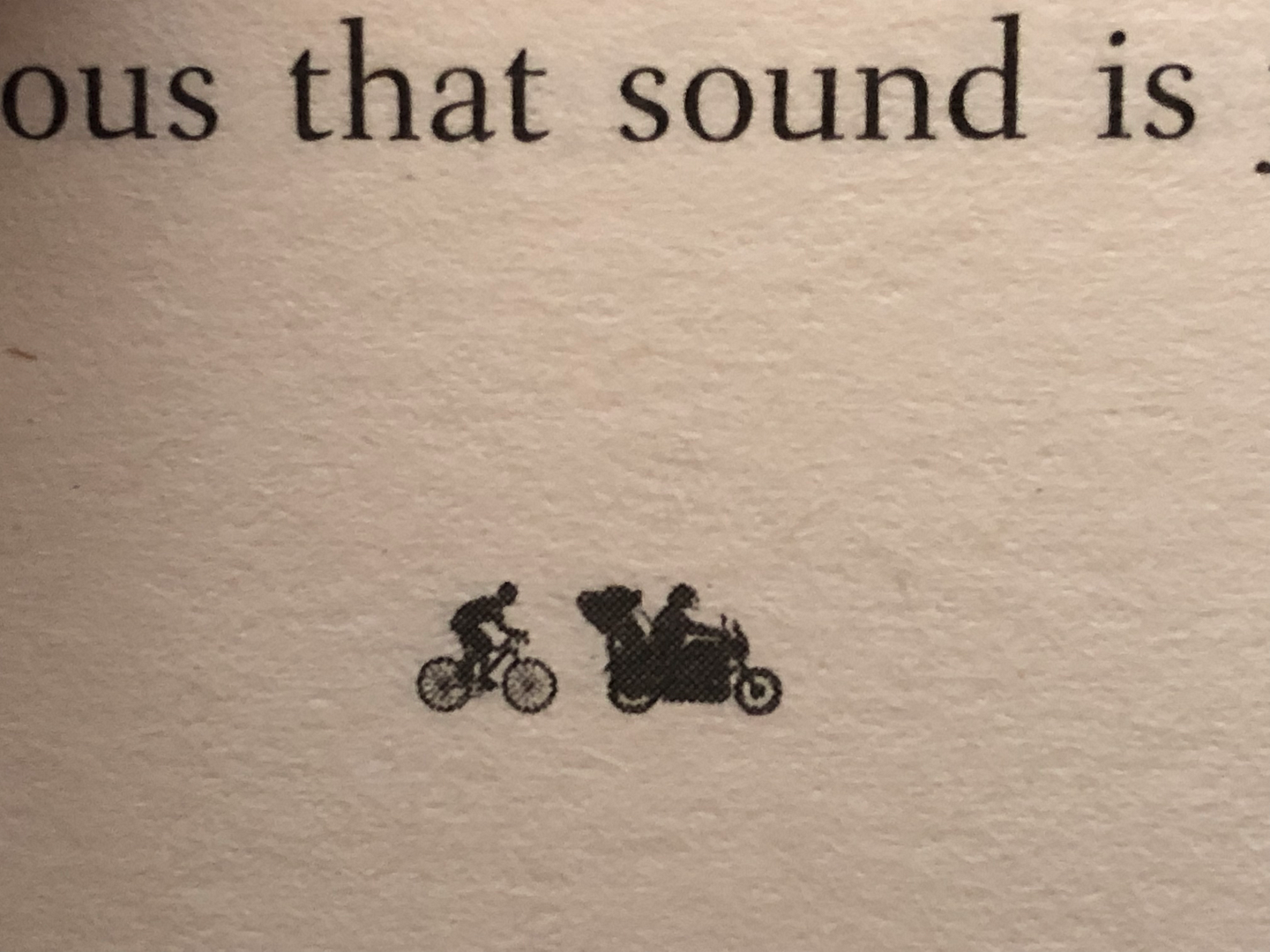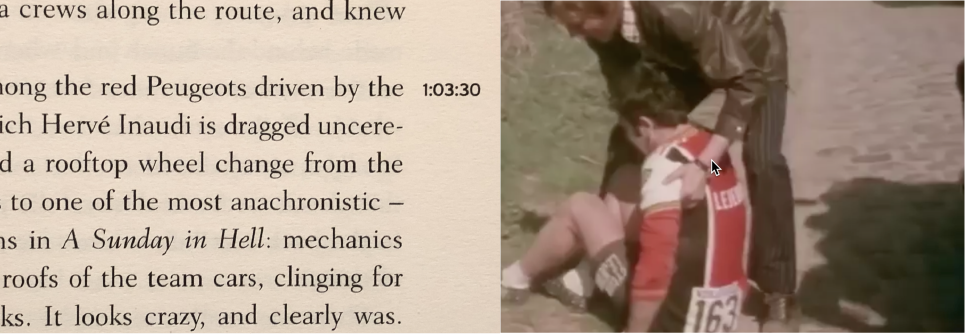
It’s a great day when a few of your passions collide. For me, its cycling, cinema and making things. Who would’ve thought there would be a day when there would be a book that could legit go on the studio bookshelf called “Cycling and Cinema” would be quickly followed by one that could also legit go up on the bookshelf — a detailed “behind the scenes” process manual to “A Sunday In Hell”
It’s happened. Just last month. What follows is a short note on the books, hopefully enough to encourage you to dig deeper into these two remarkable works.
Bruce Bennett from Lancaster University’s ‘Lancaster Institute for the Contemporary Arts’ authored this quite thorough and academic book analyzing the appearance of the bicycle in film, nothing that the two appear as cultural phenomenon nearly simultaneously and, as such, are somewhat cousins at the dawn of modernity. In ways that a cultural critic and analyst like Bennett would appreciate, they both are harbingers of the future in their emergence, not always positively.
I’ll start by saying that this book is for film analysis and film history nerds.
If you’re hoping for a book that’s heavy on production photography and stills of your favorite cycling films, skip down a bit for a behind-the-scenes book about the making of “Sunday in Hell“.
The Bennett is for those of you like me who get excited by references to Jonathan Crary’s analysis of the technics of the visual apparatus, nods to Gilles Deleuze, sections titled “Bicycles, Cameras and Cyborgs”, or passages like, “The historical coincidence of the film camera and the safety bicycle is explained partly by their status as precision-engineered machines that are dependent upon developments in industrial production.”
If this is you, just do what you’re going to do anyway and add it to your cart or hustle down to your local bookseller.
Aside from the analysis that Bennett offers are all the films you’ve never heard of that feature bicycles in some fashion. In a round about way the book (which lacks a filmography! eck!) is a well-spring of new things to dig into and watch, from independent features to shorter projects like “The History of the Wheel”, done by enthusiasts with no production team, no Craft Services nor 20-somethings helping out with clipboards and walkie-talkies.
As Instagram or YouTube suggest, there are a lot of enthusiasts out there for both cycling and cinema, and Bennett doesn’t shy away from embracing and discussing the “new” technologies of visual story telling, from GoPros to VR.
While this book is heavy on the film analysis and light on the production photography and still frames, its heart is in the right place. As mentioned previously, one notable absence from the book is a comprehensive filmography, something that would help make a Watch List would have been nice. (I’ve emailed Bennett to see if he has one on a scratchpad somewhere that he could share.)

I’ve got a rule that runs in my head whereby anytime there is a “Behind the Scenes” genre of book for a film I have even a passing fascination with, I’m allowed to add it to the library.
Why this rule?
As a “process” nerd, I’m fascinated by how things get made. Seeing the ways an idea or vision or screenplay gets translated into a material thing through the persistence and grit of a collective of humans and tools is fascinating to read and see, as well as learn about and learn from.
So, I was pleasantly surprised when, nearly coincident with the Bennett drop, a “Behind the Scenes” book on “A Sunday In Hell” came out.
I’m talking of course about William Fotheringham’s [Sunday in Hell: Behind the Lens of the Greatest Cycling Film of All Time
This is a proper “behind the scenes” book about what many argue to be the finest cycling documentary ever done. I haven’t seen a lot of cycling documentaries, but this in my opinion is cinematically one of the more exquisite visual stories. (I’ve written about the director in the recent past, if you’re experiencing a moment of déjà vu.)
Perhaps it is because it was done in a time and era when the burden of filming on the go was such it required an extraordinary level of commitment and dedication to the subject — as well as actually filming on the run with bulky burdensome equipment and film. Jørgen Leth, who directed A Sunday in Hell, clearly has the grit, vision and passion for the subject. The opportunity to make a film about his favorite sport with his heroes in an epic, brutal race keeps him on the path of a daunting technical and squirrelly financial endeavor.
For film and process nerds you’ll be gratified to find that barely is a detail left undescribed (nor flight of whimsy avoided as indicated by the fun little ‘flip book’ characters racing around in the bottom margin of the book.)
The intimate details we are provided are a credit to the remarkable excavation undertaken by Fotheringham to bring us to the moment of the film’s production, as well as the particulars of the racing culture and rules at the time.
Watching mechanics riding on the top of team cars during the race to make for fast wheel changes is whacky enough, but then we also learn about the somewhat brutal and sharp elbows amongst the teams and racers was largely the reason for this:
“It seems self-evident that the need to swap the wheel rapidly was due to the fact that the rider had to get moving as soon as possible. However, that is only part of the story. What actually mattered more was to keep the car positioned high up the convoy of team vehicles so that the leader could receive a wheel or a bike rapidly if needed. ‘On those roads, when the team car stopped to do a proper change for a rider, it would drop back to twentieth in the convoy — and as you came back up the line sometimes there would be rivals who would play it clever and bloc you — so you wouldn’t want to stop’, said Godefroot [directeur sportif].”

The level of description is pleasantly detailed, including timecode in the margins to help orient you to a specific scene as he describes this or that detail. This is something that most film books — whether film theoretical or of this “behind the scenes” genre, will not go through the trouble to do. This is truly for those who are deeply gratified by reading something written by someone else who appreciates the both the film and the endeavor to create it.
[Sunday in Hell: Behind the Lens of the Greatest Cycling Film of All Time] by William Fotheringham
[Cycling and Cinema] by Bruce Bennett
